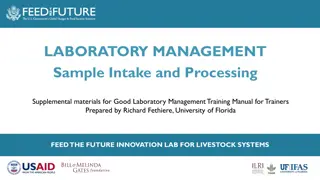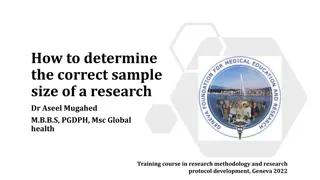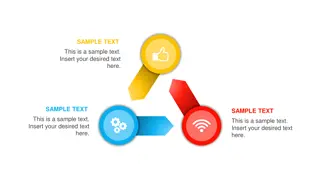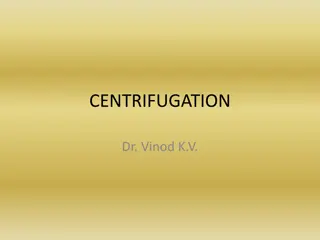Laboratory Sample Intake and Processing Procedures
Efficiently manage sample intake and processing in your laboratory with these supplemental materials. From submission checklists to sample preparation guidelines, ensure accurate analyses by following these organized procedures. Capture essential information through submission forms, labeling standa
11 views • 15 slides
Guidance for the training of cervical sample takers
Efficient and accurate cervical screening sample requests are crucial for timely and appropriate patient management. Utilizing the Open Exeter system, sample takers can access pre-populated forms to streamline the process. When deviating from Open Exeter, providing a valid explanation ensures contin
7 views • 13 slides
Determining Sample Size for Research Studies: Factors and Considerations
Sample size estimation in research is a crucial step that involves various factors such as effect size, population standard deviation, power of the experiment, and significance level. The effect size indicates the practical significance of research findings, with common measures like Cohen's d and P
2 views • 24 slides
Techniques for Sample Spotting in Mass Spectrometry
Learn about different sample spotting techniques including Dried Droplet, Crushed Crystal, Thin Layer, and Sandwich methods used in mass spectrometry analysis. Each technique involves specific steps for preparing and applying samples on a sample plate before analysis. Ideal sample concentrations for
10 views • 6 slides
Protein Sample Clean-Up Methods for MALDI Analysis
Protein sample clean-up for MALDI involves removing various contaminants like buffer, salts, urea, guanidine, EDTA, glycerol, DMSO, and detergents through methods such as dilution, washing, drop dialysis, cation exchange, and solid phase extraction using Zip tips. The process aims to reduce interfer
0 views • 8 slides
Utilizing Bayesian Regression Models for Small Sample Education Decision-Making
Bayesian regression models can be valuable tools for addressing the challenges of small sample sizes in educational research, particularly in the Pacific Region where data availability is limited. These models offer advantages for conducting robust analyses and informing system-level education decis
2 views • 25 slides
Unique Sample Text Images Collection for Creative Projects
Create captivating visuals with this diverse collection of sample text images. From customizable text layouts to percentage displays, this set offers a range of design elements to elevate your creative projects. Explore different styles, colors, and compositions to enhance your presentations, websit
7 views • 10 slides
Advances in Sample Size Calculations for Clinical Trials: The ART Suite
This presentation discusses the importance of sample size calculations in research studies, especially in the context of clinical trials. It covers tools like ART and Power in Stata for binary and categorical outcomes, emphasizing the need to determine the right sample size to ensure research questi
3 views • 35 slides
Understanding Sample Size and Effect Size in Medical Statistics
Explore the crucial aspects of power analysis, sample size determination, effect size estimation, and their interrelations in medical statistics. Learn how these components influence experimental design and decision-making in research studies. Discover the significance of adequately balancing sample
1 views • 46 slides
Back Titration in Analytical Chemistry
Back titration is a technique used in analytical chemistry to determine the concentration of an analyte by reacting it with an excess of another reagent first, followed by titration of the excess reactant. This method is especially useful in cases where direct titration endpoints are difficult to di
2 views • 14 slides
Understanding the Applications and Design of Analytical Ultracentrifugation
Analytical ultracentrifugation, a powerful technique in biochemistry, allows for precise measurement of sample properties and characterization of macromolecular complexes. The method is widely used for determining sample purity, equilibrium constants, and assembly mechanisms of biological complexes.
1 views • 17 slides
Understanding Simple Random Samples in Statistics
In this lesson, you will learn how to obtain a simple random sample using slips of paper or technology, understand sampling variability and the impact of sample size, and use simulations to test claims about population proportions. The concept of Simple Random Sample (SRS) is explained, where every
0 views • 18 slides
Understanding Factors Affecting IR Bands in Sample Preparation
Learn about the importance of sample preparation in infrared spectroscopy, including techniques for solid sample preparation and the choice of solvents to obtain accurate IR spectra. Discover how factors like inductive and resonance effects influence IR frequencies in different functional groups.
1 views • 14 slides
Introduction to Structured Text in PLC Programming
Structured text is a high-level text language used in PLC programming to implement complex procedures not easily expressed with graphical languages. It involves logical operations, ladder diagrams, and efficient control logic for industrial automation. Concepts such as sensor input, logic operation
5 views • 23 slides
Cytology Sample Taker Trainee Mentorship Program Overview
This detailed guide outlines the mentorship program for cytology sample taker trainees, including mentor responsibilities, training sequence, interim assessment process, and key changes in mentorship roles. Trainees attend courses, observe smears under supervision, and progress to unsupervised sampl
0 views • 12 slides
Water Sample Preservation, Transportation, and Storage Guidelines
Understanding the importance of timely analysis, this guide discusses factors affecting sample stability, recommended chemical preservatives for water samples, suitable containers for storage, and methods to minimize changes during transportation. It also highlights parameters to measure at the samp
0 views • 11 slides
Understanding Grow-Out Test for Genetic Purity Evaluation in Seed Certification
The Grow-Out Test is a crucial measure in seed certification to determine the genetic purity of seed lots. It helps in controlling genetic contaminations and ensuring compliance with prescribed standards. This test is essential for certain species like cotton, castor, musk melon, and brinjal in Indi
0 views • 16 slides
Understanding the Central Limit Theorem in Statistics
This lesson covers the Central Limit Theorem, which states that the sampling distribution of a sample mean becomes approximately normal as the sample size increases, regardless of the population distribution. It explains how the distribution of sample means changes shape and approaches a normal dist
1 views • 7 slides
Understanding Functional Skills: Text Analysis and Application
This instructional text guides learners through the purpose of functional skills in analyzing different types of text, such as skimming and scanning, and understanding the features of various text genres. It includes activities to practice skimming, scanning, and detailed reading, with a focus on de
0 views • 13 slides
Enhancing Accessibility Through Alternate Text in Microsoft Documents
Explore the importance of alternate text in Microsoft documents for accessibility. Learn what alternate text is, why and when you should use it, and how to add it effectively. Discover the benefits of incorporating alternate text and the legal aspects related to accessibility under Section 508. Enha
0 views • 23 slides
COVID-19 Testing Process in Wisconsin
The COVID-19 testing process in Wisconsin involves outreach, supplies distribution, patient care, and sample collection. Exact Sciences account managers facilitate testing outreach to SNFs, provide supplies, and ensure proper sample collection procedures. The process includes online ordering of supp
1 views • 8 slides
Text Classification and Nave Bayes: The Power of Categorizing Documents
Text classification, also known as text categorization, involves assigning predefined categories to free-text documents. It plays a crucial role in organizing and extracting insights from vast amounts of unstructured data present in enterprise environments. With the exponential growth of unstructure
0 views • 28 slides
Understanding Audience and Purpose in Text Analysis
When analyzing written texts, identifying the purpose and audience is crucial. The purpose reflects the reason behind the text, while the audience indicates who the text is intended for. By recognizing these aspects, one can better understand the content, language, and overall impact of the text. Va
1 views • 50 slides
Discovering a New Choice in ICP-MS Low Volume Handling: MVX-7100 Workstation Automation
Explore the MVX-7100 workstation for ICP-MS low-volume handling, offering features like reduced reagent usage, well plate compatibility, sample mixing, and more. Addressing challenges of working with small sample sizes at trace levels, this system provides automation options and is supported by rese
0 views • 33 slides
Essential Information on Text-to-911 System
Explore key details about the text-to-911 system, including capturing text conversations, handling abandoned calls, transferring text calls to queues, and managing text conversations effectively. Learn about system configurations, call release timings, and dispatcher capabilities in handling text me
0 views • 12 slides
Text-to-911 System Operations Quiz
Test your knowledge on Text-to-911 system operations with this quiz. Learn about capturing text conversations, handling abandoned calls, transferring calls to queues, text conversation timelines, and more. Enhance your understanding of the protocols and procedures involved in managing text-based eme
1 views • 12 slides
Insights into Mars Sample Return Science Inputs for Landing Site Selection
The Mars Program Office at Jet Propulsion Laboratory has conducted a systematic survey to determine landing site priorities for sample return missions. Insights from the astrobiology and cosmochemistry/petrology communities reveal key interests such as geologic age, rock-water interactions, and dive
0 views • 16 slides
Water Licence Surveillance Network Program (SNP) Guidelines
Water Licence Surveillance Network Program (SNP) provides detailed instructions on safety measures, sample collection preparation, sample locations, and analysis procedures. It emphasizes the importance of wearing gloves, getting vaccinations, using hand sanitizer, and proper field gear during sampl
0 views • 13 slides
SAS Code for Sample Size and Power Calculation in Two-Sample Comparisons
SAS code snippets are provided for conducting power and sample size analyses in two-sample comparisons using the TWOSAMPLEMEANS statement. The code covers scenarios such as two-sample t-tests assuming equal variances, unbalanced designs, unequal variances, and more. Examples and syntax are included
1 views • 10 slides
Understanding Sample Size, Power, and Hypothesis Testing in Statistics
Sample size determination based on estimation precision and confidence interval width is crucial in statistical analysis. By calculating the necessary sample size, researchers can ensure sufficient standard errors and confidence intervals. Additionally, the relationship between power and sample size
1 views • 50 slides
Approximate Inference in Bayes Nets: Random vs. Rejection Sampling
Approximate inference methods in Bayes nets, such as random and rejection sampling, utilize Monte Carlo algorithms for stochastic sampling to estimate complex probabilities. Random sampling involves sampling in topological order, while rejection sampling generates samples from hard-to-sample distrib
0 views • 9 slides
Understanding Sampling Methods in Business Analytics
Sampling plays a crucial role in estimating proportions and making informed decisions in business analytics. From polling to estimating proportions, this class explores sampling techniques, sample size determination, and potential biases. Learn about choosing a sample size, stratified and cluster sa
2 views • 23 slides
Understanding Text Representation and Mining in Business Intelligence and Analytics
Text representation and mining play a crucial role in Business Intelligence and Analytics. Dealing with text data, understanding why text is difficult, and the importance of text preprocessing are key aspects covered in this session. Learn about the goals of text representation, the concept of Bag o
0 views • 27 slides
Introduction to JMP Text Explorer Platform: Unveiling Text Exploration Tools
Discover the power of JMP tools for text exploration with examples of data curation steps, quantifying text comments, and modeling ratings data. Learn about data requirements, overall processing steps, key definitions, and the bag of words approach in text analysis using Amazon gourmet food review d
0 views • 23 slides
Genomics Facilitator's Toolkit Summary & Sample Requirements
This toolkit provides essential resources for healthcare professionals involved in genomics services, covering topics such as genomic medicine, whole genome sequencing, clinical genetic testing methods, interpretation of DNA variants, and more. It also details the specific sample requirements for di
0 views • 24 slides
Understanding Bigrams and Generating Random Text with NLTK
Today's lecture in the Computational Techniques for Linguists course covered the concept of bigrams using NLTK. Bigrams are pairs of words found in text, which are essential for tasks like random text generation. The lecture demonstrated how to work with bigrams, including examples from the NLTK boo
0 views • 19 slides
Sample Text and Image Elements Showcase
This sample content demonstrates the use of text and image elements in a structured manner. It includes titles, paragraphs, bulleted lists, and image captions with corresponding descriptions. The content showcases how different types of content can be organized visually.
0 views • 5 slides
Enhancing Reading Comprehension Through Text-Dependent Questions
This resource delves into the significance of text-dependent questions in improving students' reading comprehension skills by emphasizing the importance of evidence from the text, building knowledge through nonfiction, and developing critical thinking abilities. It highlights key advances in educati
0 views • 16 slides
Understanding Parameters, Statistics, and Statistical Estimation in Statistics
In statistics, we differentiate between parameters and statistics, where parameters describe populations and statistics describe samples. Statistical estimation involves drawing conclusions about populations based on sample data. The Law of Large Numbers explains the relationship between sample stat
0 views • 12 slides
Understanding Estimating and Testing Variances in Statistical Analysis
Estimating and testing variances is crucial in statistical analysis. Population and sample variances are key measures of squared deviations around the mean. Sampling distribution of sample variances, specifically for normal data, follows a Chi-Square distribution. Understanding Chi-Square distributi
0 views • 31 slides







































